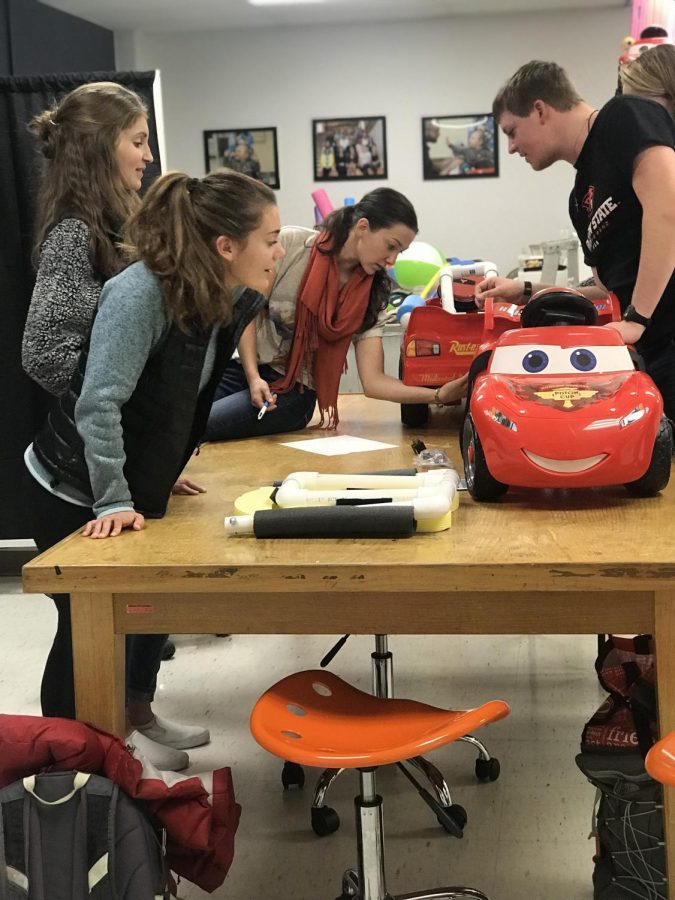Go Baby Go aims to improve lives of kids living with disabilities
January 7, 2019
Oregon State University is known as a leading research university, with a wide variety of different kinds of research conducted on campus. The Go Baby Go program is just one of the many significant contributions that the college of Public Health and Human Sciences makes to the university’s scientific research.
The college’s focus is to study individuals across the life course, focus on health equity, address health disparities and conduct both basic and applied research, including research on the translation of public health programs to real-world settings.
One program at OSU, called Go Baby Go, was introduced to the College of Public Health and Human Sciences in 2014, under the direction of Assistant Professor Sam Logan. Go Baby Go is a community-based, national research, design and outreach program that provides modified ride-on cars to children from birth to age three who experience limited mobility. This program provides modified ride-on cars to families not only in living in Corvallis, but all around the state of Oregon.
Go Baby Go provides an affordable solution for the ongoing struggle of finding commercially available electric wheelchairs for young children.
“There is no commercially available device for this age group and so for a couple hundred dollars, with the modifications, supplies and the cars, it’s all inclusive, we can provide that gap in technology,” Logan said. “There is a lot of research that suggests that when children are provided access to these kinds of powered mobility devices, whether it’s motorized wheelchairs or modified rise-on cars, that they experienced developmental benefits like physical, communication and social skills.”
Kinesiology students in the CARS club modifies the ride-on cars to accommodate specific limitations. PVC pipes are used to create structure and stability to the cars, large activation buttons are added to the steering wheels for easy activation and stop and go coordination, seatbelts are added for children who need extra trunk support, as well as many other modifications that vary on the child using the car. The club makes the general modifications and later individualizes it for the child that will be receiving the car.
Vice President of CARS club and member of the Social Mobility Lab, Christina Cafferata, who is also a third-year kinesiology major, has been able to participate in multiple experiences through the club to help prepare her for her goal of becoming a physical therapist. She has also seen the direct effect of CARS’ work on the lives of children who were previously unable to move around on their own.
“I’ve been able to attend a workshop for physical therapists as well as a workshop at OHSU where children were given cars, along with numerous other outreach events on the OSU campus,” Cafferata said. “I’ve learned to modify ride-on cars and I get to see children with disabilities moving independently for the first time ever.”
There are many opportunities that Go Baby Go provides not only to the children, but to those who are making contributions to the program as well. Any student involved in the program, whether it is the physical construction of the cars or the research behind it, can learn valuable skills and lessons along the way.
“These events not only greatly improved my public speaking skills, but have also motivated me to keep working hard in school so I can become a physical therapist,” Cafferata said.
The Social Mobility lab conducts the research portion of Go Baby Go and does a variety of projects.
For example, one project specifically focuses on the attitudes of families and caregivers towards children with disabilities, social mobility, or self-directed mobility. The Social Mobility lab looks at the attitudes of those families that are receiving the cars and how it impacts the children’s access to the ride-on cars that are offered. They provide the cars to families in need, then checks back in a couple months later to figure out how much the child used the car. This allows them to recognize what factors impacted how little or how much they used the ride-on car.
Jenna Fitzgerald, a fourth-year public health major with an option in health promotion and health behavior, took on student research in the Social Mobility lab her first year of college.
“I think that what we’re going to get from this study is many different things, but one that we are going to find is the way Go Baby Go supports communities. For example, constantly checking up on families will give us an idea of how much the children are using the cars,” Fitzgerald said.
Fitzgerald hopes that her research will make the Go Baby Go program more suitable to the lives of the families who could benefit from them, and ultimately improve the lives of children with mobility disabilities.
“My work with this specific project is hopefully, in the future, going to help structure the way Go Baby Go functions in terms of improving the experience that families have with the program,” Fitzgerald said. “Hopefully by doing that, it will help to facilitate the use of these cars which will improve the development of these children.”
Go Baby Go provides an option for families who cannot afford electric wheelchairs for their child, especially when children are constantly growing and may grow out of their wheelchair. The program has many working parts that make it such an important role in so many families. Whether it is the construction of the cars or the research behind it, Go Baby Go is a significant contributor to the access of motorized transportation for young children with disabilities.
























































































































